Subscription information. Disclaimer, copyright and licensing
Introduction
NZ farmers and growers are faced with a rapidly changing environment: climatic, production as well as political, that they have to operate within and adapt to. Therefore any new tools, that can help solve problems, or better, even improve their farm and financial performance, are welcome. While it is early days yet, Miscanthus could be one such tool.
Miscanthus is grass on steroids. Its a genus of about 15 perennial grasses from the subtropics of Africa and Asia, of which Miscanthus x giganteus is the most well known, as it has been used as a biofuel crop in Europe since the 1980s. It is a naturally occurring, sterile, hybrid, that grows up to 3.5 meters high (Figure 1), can produce upwards of 30 tonnes/ha dry matter, and looks like a halfway house between a cereal and bamboo, in that the canes look like bamboo but are thinner and not as strong (Figure 2).
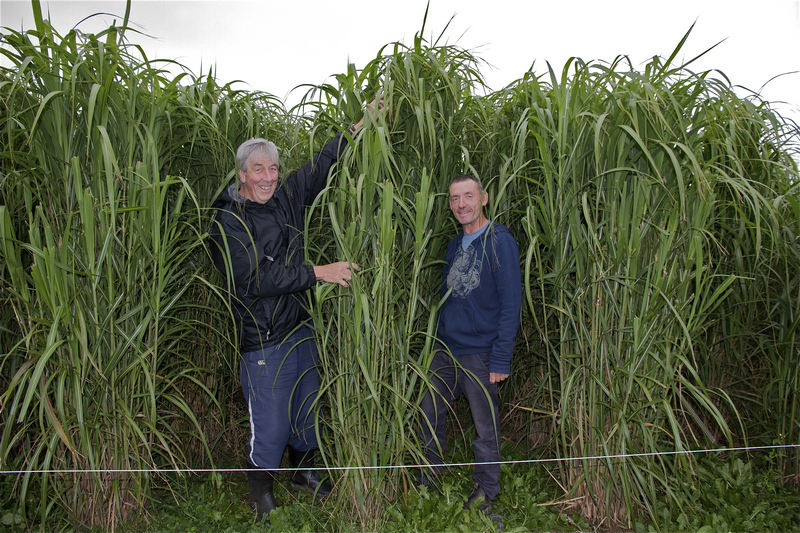
Figure 1. Miscanthus x giganteus, with Prof. Steve Wratten (left) and Chris Littlejohn of Lincoln University. Photo credit Auldwood Photography.
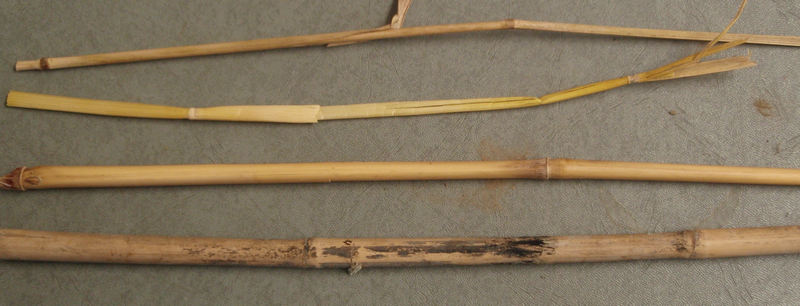
Figure 2. Stems of, from top, grass, cereal, Miscanthus x giganteus and bamboo.
While its main use to date has been for biofuel, two scientists at Lincoln University, Chris Littlejohn and Prof. Steve Wratten (Figure 1) have been researching the potential for Miscanthus as a multi-functional tool for dairy farmers on the Canterbury plains: to provide shelter for stock – that is compatible with pivots, improve pasture performance, create a potentially valuable additional crop and the cherry on the top is that it can improve biodiversity. However, the potential for Miscanthus is not limited to Canterbury dairying – it has considerable potential value for all agricultural and horticultural systems across New Zealand.
Shelter
Canterbury is renowned for the Nor’wester, of which the Sept 2013 storm, which bowled over 800 odd irrigators, including a large number of center pivots, was a sobering reminder. However, Canterbury is not the only windy place in NZ thanks to the country being in middle of the roaring forties. Cold winter and spring southerlies can be as problematic as hot summer winds. Research is also laying to bed the old idea that shelter is bad for stock performance, for example, cattle with access to shade actually grazed 30-40 minutes longer than cattle without, heat stress is a major issue for reduced stock productivity [1, 3], and newborn stock losses to spring southerlies is well known. The value of shelter for crops, especially vegetables, is well established.
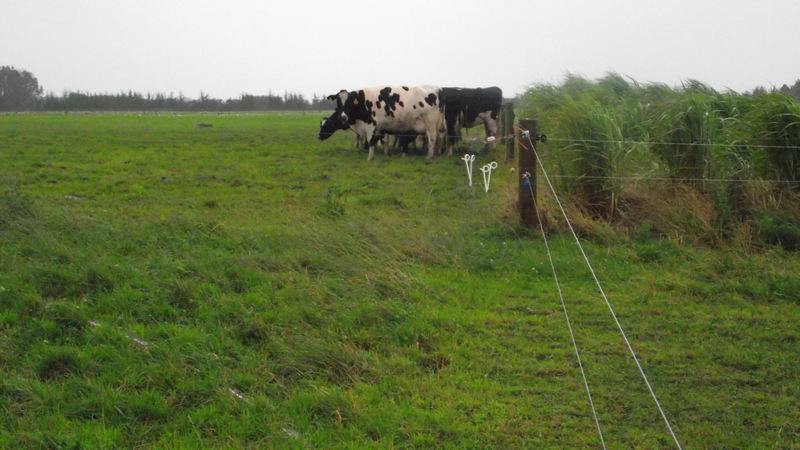
Figure 3. Cows sheltering from southerly behind Miscanthus. Photo credit Christ Littlejohn.
It is therefore clear that effective shelter is an important component of stock farms as well as cropping and vegetables. However, shelter belts are one of those farm infrastructure components that often feels like a financial black hole, a maintenance job that keeps falling off the to-do list, until the trees fall over, ironically, in the big wind that they are supposed to be protecting the rest of the farm from. Plus there are the issues with stock camps, dead pasture or reduced crop growth next to the tree line, etc., all of which makes standard shelter trees such as poplars, pines and macrocarpa less than perfect.
In addition the reason so many irrigators were blown over in Sept 2013 storm was that a lot of shelter had been removed due to dairy conversions, which installed center-pivot irrigation. The use of pivots has been driven by the need, and political / public desire for, more efficient irrigation. Pivots are undoubtedly much more efficient than the old irrigation systems, such as rotorainers, especially when using variable rate irrigation systems. However, the very obvious thing about pivots are they are incompatible with trees, so the shelter trees have to be removed, but then nothing is put in to replace them, resulting in large open farms which are very susceptible to wind. Finding a new shelter species for Canterbury dairy farms was a key driver for the Lincoln Uni research.
In comparison with the traditional shelter trees Miscanthus has a lot to offer. Establishment takes about the same amount of work as planting a tree shelter belt, and after the first full year, it is maintenance free, i.e., it does not require thinning, trimming, etc. This is because it is rhizomatous, so it regenerates itself anew each year. Typical bio-energy crop Miscanthus which is harvested every year lasts for around 25 years, and , where it is not harvested it could persist for a very long time indeed. In the same time period, pines will have gone from transplants to full sized trees that are ready, or have to be, removed with all that entails.
As the maximum height of Miscanthus is four meters it never becomes overbearing like many trees, which coupled with the fact that its roots don’t compete with the adjacent pasture, grass can grow right up to the fence and competition with crops is equally slight. As it is not as high as trees the downwind shelter does not spread as far as trees, which means that more shelter breaks are required, however, that also means that there are many more locations for stock to shelter from both southerlies and northerlies, and without big overhanging branches concentrated stock camps are much less of an issue. And, as Miscanthus has bendy bamboo like stems, and grows anew again each year, there is no possibly of it blowing over, unlike trees.
Miscanthus also has significant benefits over other lower growing shelter species such as flax, which is notorious when it comes to mechanical trimming, and toetoe (Austroderia spp) which with its very dense bases is ideal habitat for mice and other vermin, while the open base of Miscanthus is much less of a mouse haven.
And the key point for pivot irrigators, is that they pass straight through Miscanthus as it bends or breaks out of the way of the wheels and superstructure and the thin upright stems have nothing to catch the irrigation nozzles on.
So compared with other shelter, Miscanthus has a lot going for it, and as its clear all NZ farms and horticultural holding need more shelter options, not just dairy farms in Canterbury, Miscanthus could have a valuable future role across the whole of NZ.
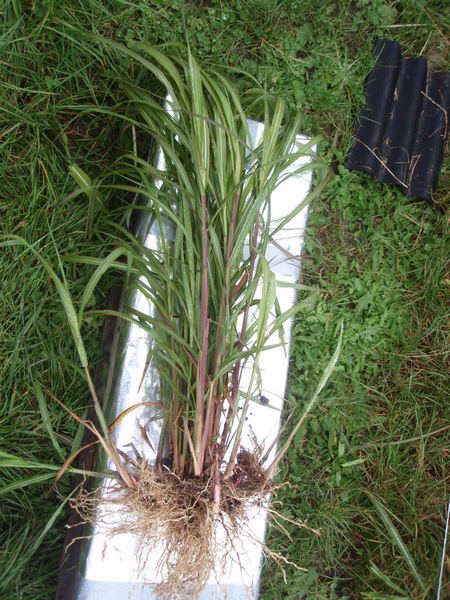
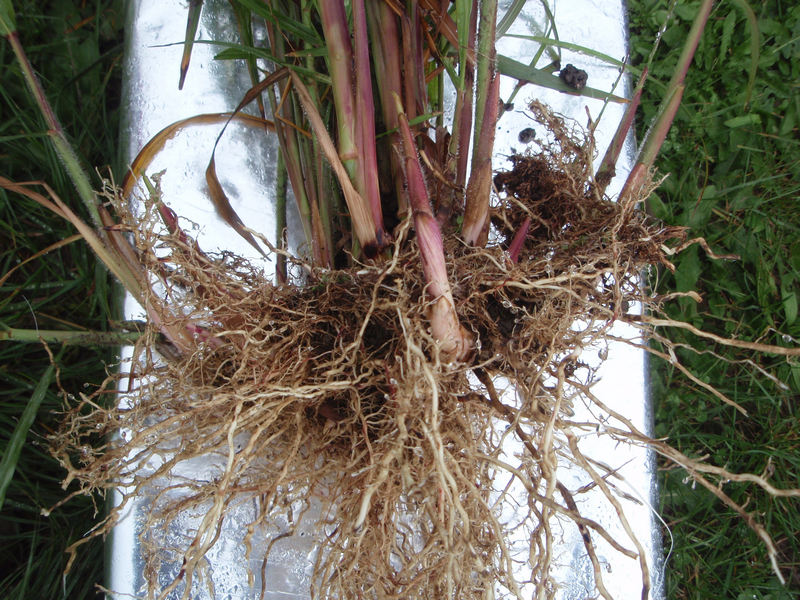
Figure 4. Miscanthus plant (left) with closeup (right) showing roots and rhizomes.
Pasture shelter
However, it is not just stock that needs shelter from wind. Pasture production, the same as pretty much any other plant crop, benefits from good shelter. This is where the Lincoln Uni researchers have been getting under the bonnet and measuring how pasture plants react to Miscanthus shelter. For example, they found that clover plants keep their stomata open wider and longer when protected from Nor’westers than unprotected plants which has resulted in an overall increase in pasture dry matter of 18% within 40 meters downwind of the Miscanthus [2], a clearly pretty sizable increase in pasture growth. This was coupled with a 20% reduction in evapotranspiration due to the sheltering effect. This was also with Miscanthus that had not yet reached its full height as the plants were only in their second year. Typically the shelter effect would be expected to reach ten to twelve times the plant height, so for four meter plants that is up to 50 meters of shelter, though the shelter effect does drop off with distance. Where the majority of field boundaries are planted with Miscanthus there is potential for additive effects of the multiple shelter belts as the plants slow the wind repeatedly across the farm.
Arable / vegetable shelter
As arable and especially vegetable farms often need better shelter than livestock operations, coupled with the fact that Miscanthus has very few pests and diseases, so it wont act as an alternative host or reservoir for crop pests and diseases, plus all the benefits Miscanthus has for pasture systems, e.g., very low maintenance, means that Miscanthus could also have considerable potential as shelter on vegetable and arable operations.
Secondary benefits
While the main focus of the Lincoln Uni Miscanthus research has been on shelter there are many other uses and benefits for Miscanthus.
Animal bedding
Miscanthus makes good animal bedding as it is a lot tougher than cereal straw so it lasts longer, and it has other beneficial properties such as smell reduction. Overseas, it is particularly popular as a bedding for horses due to its low dust content. A key factor in the economics of Miscanthus for bedding will be the local availability and price of alternatives such as cereal straw, as transporting straw long distances adds significantly to the cost, so in areas with limited cereal production, e.g., Southland, then Miscanthus straw for bedding could be in strong demand. Or it could be a valuable home-grown substitute on dairy farms for bought in straw for use in overwintering sheds and calf pens.
Stock feed
While Miscanthus is palatable to stock, as evidenced by cows happily grazing the plants in-situ in the field trials, it is a pretty low grade feed. The senesced stalks, as harvested for bio-fuel, are even lower feed value than maize residues, with nitrogen of only 0.2%, metabolisable energy (ME) of 3.2 MJ/kg DM and with all other measures of feed value at very low levels compared with mixed pasture, with the exception of manganese and fibre / lignin levels. Green Miscanthus i.e., harvested or grazed when it is still actively growing, has a better profile, with 2.5% N, ME of 9.1 and most other measures pretty middle of the road. However, if Miscanthus is grown for harvesting green then its fertiliser requirements increase considerably – see the production section for more information. A more viable use for the senesced stalks is the roughage component of a total diet formulation for stock, and again, this could be particularly valuable in areas where access to cereal straw is limited.

Figure 5. First years growth of Miscanthus fully senesced at the end of second season. Photo credit Chris Littlejohn.
Bio-energy
The main use of Miscanthus in Europe has been as a bio-energy crop, often being driven by significant subsidies. However, even in NZ, where there are no such government hand-outs, there is still potential profit to be made growing Miscanthus for energy. There are a number of ways that Miscanthus can be used as fuel.
At the most basic, baled Miscanthus straw can be used in boilers, e.g., as a replacement for coal, i.e., large commercial boilers or even specialised domestic renewable fuel boilers. For example, you could heat the farmhouse off it and it could be used as a coal substitute in milk factories for milk drying and other high energy requirements, which would improve the sustainability profile of NZ milk.
Next is fuel pellets, i.e., for domestic wood pellet fires. This requires a pellet mill, and while there are wide size range of pelleting machines down to those for domestic use, to do the job well, generally requires experience and industrial sized machines. So, while there is potential for buying a mill and converting Miscanthus into pellets for local sale, the more straightforward option is to sell baled straw to existing pellet companies. These have expressed interest in finding alternative source materials to wood, due to both increasing sawdust prices and competition for this resource.
The third option is likely to be of most interest to farmers and growers: conversion of Miscanthus to renewable diesel. It is very important to note the difference between bio-diesel and renewable diesel. Bio-diesel is made from oils or fats and is a product sufficiently different from normal diesel that it has its own specifications. Many engine warranties are voided if biodiesel is used for more than 5% of the fuel and if diesel contains more than 5% biodiesel it cannot be labelled as diesel. Renewable diesel, while also made from plants, is not made with oils or fats rather it is made from the cellulosic / woody parts of plants, e.g., stems, and it is virtually indistinguishable from normal diesel. Engine manufacturers will stand behind their warranties even if 100% renewable diesel is used and as it meets standard diesel specifications (not biodiesel specifications) it can be sold as regular diesel. Miscanthus is used to make renewable diesel, however, the machinery required to do so is pretty substantial, with price tags in the million bracket, so this is something that will likely require a group of farmers and growers to co-operatively invest in. However, as a teaser, 30 tonnes of miscanthus converts into 9,000 litres of renewable diesel nett of the diesel used to power the conversion process, at a cost of about $1.10 / litre. This is cheaper at the time of writing than the $1.20 of diesel at the pump which is the lowest it has been for five years, and assuming a Miscanthus yield of 30 tonnes / ha, that is an income of $9,900 /ha.
However, while all the above energy uses for Miscanthus are already well proven overseas, there is still a way to go before such markets become established in New Zealand, but it does show that Miscanthus can provide a direct income, above and beyond its on-farm benefits, and the returns could make it one of the better paying products on the farm.
Biosecurity / pest risk
One of the key concerns of government, the public and farmers about introducing new plants is the potential for them to become problem weeds – both on farmland and the conservation estate. One of the key benefits of Miscanthus is that because it is a hybrid it is completely sterile so it does not produce seeds, which dramatically reduces its potential for escape. In addition, while it is rhizomatous, it spreads only slowly, e.g., ten centimetres a year, and as it is palatable to stock they will also keep it in check if it grows beyond the fence. This is why ERMA (the Environmental Risk Management Authority) approved the release of Miscanthus in 2007 (see https://www.epa.govt.nz/database-search/hsno-application-register/view/NOR06003).
Biodiversity and environmental benefits
The flip side to Miscanthus not posing a biosecurity / pest risk, the Lincoln researchers have shown that Miscanthus plantings can provide positives for the environment such as providing habitats for bumble bees and native skinks. Some of these, e.g., bees may also be beneficial for the farming or growing operation, e.g., clover or seed crop pollination. With overseas markets increasingly making purchasing decisions on the overall sustainability of our farm systems, Miscanthus’s ability to improve biodiversity and other ecosystem services could be a valuable extra selling point.
Production / management
As noted in the shelter section above, establishment, and especially management of Miscanthus is pretty easy.
Establishment
While establishing Miscanthus is straightforward there are a few key things to get correct for best results.
While Miscanthus is very competitive once established, like any newly planted crop, including trees, it needs to have competition removed at establishment. Therefore all other vegetation should be eliminated before planting, either though herbicides or cultivation / tillage. Weeds also need to be kept down during the first growing season, and until December of the second season. After that time the Miscanthus will fully occupy the site and will out-compete the weeds. Higher density plantings will reduce the time to full occupancy and therefore reduce the length of time weed control is required.
As Miscanthus is palatable, especially the young growing stems and leaves then stock have to be kept off at all times. Suitable permanant fencing is therefore essential.
Hard ground, especially pasture, needs to be worked up, and as Miscanthus is very deep rooting, if there are soil pans or dense layers, these should be sub-soiled / deep ripped. Potentially the ripped lines can be used as the planting lines.
Two options exist for planting, either rooted transplants or sections of rhizomes. As Miscanthus is sterile, there are no seeds produced, so it can’t be established from seed. Transplants are more expensive than rhizomes, but have better establishment success. Plant spacing is about one meter on the square, which is generally the most economic but plants will take several years to grow into the gaps. Higher plant densities will give faster ground cover and more shelter in the early years, but at increased cost.
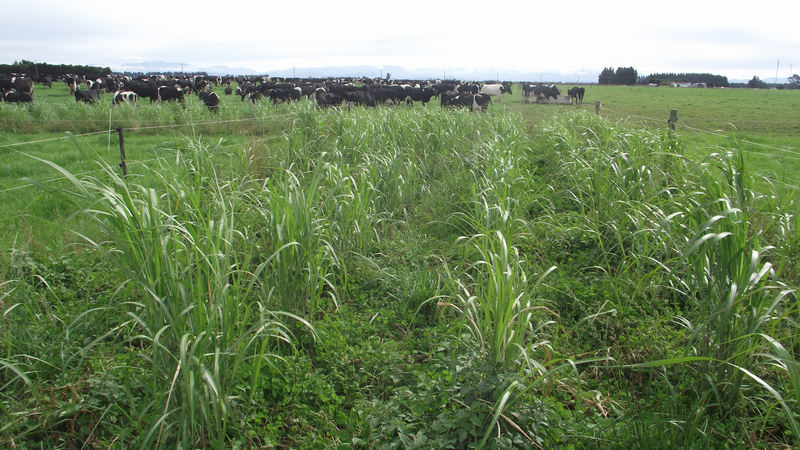
Figure 6. First seasons growth of Miscanthus in April.
Generally a vegetable transplanter or potato planter is used although specialist planters have been developed in Europe and North America. Planters ensure accurate planting depth much greater speed. However, these can only cope with soft ground which is why cultivation is required or the sub-soiler line is used.
A key point is that as Miscanthus is a sub-tropical plant, it is sensitive to cold, and while it can handles light frosts and soil temperatures down to -3°C a hard frost can damage young plants so planting should be delayed until the main frost season has passed.
While established Miscanthus has low nutrient requirements, due to low nutrient removal, it requires sufficient soil nutrients to establish so, soil tests should be conducted and nutrient levels brought up to the standard levels for pasture. If only dry dead Miscanthus stalks are harvested in spring then nutrient removal is very low and no additional fertilisers are required. However, if Miscanthus is harvested or grazed when green then fertiliser applications at similar rates to pasture will be essential along with regular soil testing.
Finally, good soil moisture levels are required through the first season, i.e., until Miscanthus has established deeper roots. In summer moist areas, no irrigation will be required but in dry areas, i.e., the east coast of both islands, irrigation is essential.
Miscanthus also has practically no pests or diseases and none that cause any significant plant damage, so no P&D control is required.
Maintenance
Once established, maintenance is very easy: it can literally be a case of shut the gate and walk away – for decades, as the plants will just grow and senesce each year with new stalks growing up through the old ones.
If the Miscanthus is harvested, which occurs in about August to September depending on latitude, the main maintenance is the harvesting, which is typically done with a maize / forage harvester – so the planted area between the fence lines needs to be wide enough to comfortably drive the harvester between.
Once it has established deep roots, it can access deep soil water and as a C4 plant, which is more water efficient, irrigation is not essential, however, if biomass production is a focus then in dryer areas irrigation during the main growth period of Dec to April will boost yield considerably, e.g., from 20 to 30 tonne/ha.
Conclusions
While global interest in Miscanthus has focused on biofuel production, its potential benefits are much wider. A key advantage for NZ agriculture and horticulture is as a lower cost and easier to manage wind shelter compared with pines, poplars and macrocarpa. However, there are a range of other benefits as well, including its use a biofuel, which with potential returns for renewable diesel comparable with some of the best gross margins for both farming and horticulture, Miscanthus could be the most profitable shelter on the farm.
People involved
A number of people have been involved in the research, providing funding and promoting Miscanthus.
Chris Littlejohn, Prof. Steve Wratten, Dr Tim Curran and Dr, Rainer Hoffman from Lincoln University http://www.lincoln.ac.nz/
Dr Samuel Dennis from AgResearch, Lincoln http://www.agresearch.co.nz/
Chris Pullen from Westland Milk Products who are the main sponsor of the research http://www.westland.co.nz/
Peter Brown from Miscanthus New Zealand Limited http://www.miscanthus.co.nz/
DairyNZ http://www.dairynz.co.nz/
Thanks
Particular thanks to Chris Littlejohn and Peter Brown, the former for being interviewed and both for technical checks on this article.
Further resources and information
https://www.teagasc.ie/media/website/publications/2011/Miscanthus_Best_Practice_Guidelines.pdf Teagasc – ‘Miscanthus Best Practice’
https://en.wikipedia.org/wiki/Miscanthus_giganteus
References
1. Betteridge, K., Costall, D., Martin, S., Reidy, B., Stead, A., and Millner, I. Impact of shade trees on angus cow behaviour and physiology in summer dry hill country: grazing activity, skin temperature and nutrient transfer issues. in Advanced Nutrient Management: Gains from the Past – Goals for the Future. Occasional Report No. 25. . 2012. Palmerston North, New Zealand: Fertilizer and Lime Research Centre, Massey University. http://www.massey.ac.nz/~flrc/workshops/12/Manuscripts/Betteridge_1_2012.pdf
2. Littlejohn, C.P., Wratten, S.D., Curran, T.J., Hofmann, R.W., and Dennis, S.J. Shelter provided by a bioenergy crop (Miscanthus x giganteus) increases pasture production on dairy farms. in 5th Australasian Dairy Science Symposium. 2014. Hamilton, New Zealand: Australasian Dairy Science Symposium. https://www.researchgate.net/publication/280626973_Shelter_provided_by_a_bioenergy_crop_Miscanthus_x_giganteus_increases_pasture_production_on_dairy_farms/stats
3. Verkerk, G., In summer, shade rules the science behind why trees help maintain dairy productivity. New Zealand Tree Grower, 2009. February. https://www.nzffa.org.nz/farm-forestry-model/resource-centre/tree-grower-articles/february-2009/in-summer-shade-rules-the-science-behind-why-trees-help-maintain-dairy-productivity/
